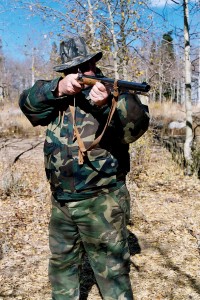 Regardless of the abundance of game or a hunter’s observation and tracking skills, a poor shooter won’t bring home the bacon. Shooting fundamentals are best taught rather than learned by trial and error. Hunter education, which is required by most states, plays a key role in preparing young hunters in developing the skills necessary for harvesting game.
Regardless of the abundance of game or a hunter’s observation and tracking skills, a poor shooter won’t bring home the bacon. Shooting fundamentals are best taught rather than learned by trial and error. Hunter education, which is required by most states, plays a key role in preparing young hunters in developing the skills necessary for harvesting game.
Remember to use your dominant eye. Sometimes a new shooter fails to hit the target, because they mistakenly use their weak eye rather than their master eye to sight in. One way to determine the master eye is to focus on an object in the distance and enclose the object within an opening in your hands. Close one eye and then the other. The object will be obscured, when one eye is closed, but will stay in focus with the other eye. That’s the master eye and the one that is used in shooting.
Breath control is key. For a sure shot, inhale until you fill your lungs. Exhale half the air and hold your breath, while the shot is being taken. If your chest is moving, shot placement will be wild and inconsistent. Even for experienced shooters, breath control is difficult in a hunting situation, where physical exertion or “buck fever” causes heavy breathing. However, until you can hold your breath, wait to take the shot.
Stabilize your firearm. On a shooting range, hunters sight in with the benefit of a bench rest. Unfortunately, there’s no such advantage in the woods. That can be compensated for with some forethought. Attach a bipod to your rifle stock or bring “shooting sticks” along. Both offer the advantage of stabilizing the gun. Absent these, rest the forearm of your rifle on a backpack, coat, branch or rock. On hard surfaces, make sure the fore stock is cushioned by something soft, such as a hand, coat or hat. That will prevent the barrel from bouncing upon ignition and throwing your shot.
Squeeze, don’t pull. New shooters and even experienced hunters in the excitement of the hunt sometimes pull rather than squeeze the trigger. The quick movement from the index finger will move the rifle slightly and change shot placement. Accurate shooting is achieved only when the pressure on the trigger is so slight that the moment of firing takes the shooter by surprise. That’s difficult in a hunting situation, when game is moving quickly into cover or out of the range of fire and the hunter fires too quickly.
Practice makes perfect. Hunter education followed up by frequent, supervised practice will ensure that proper shooting techniques are so firmly imprinted in muscle memory that when the moment of truth arrives, proper shooting techniques will be subconscious and automatic.
